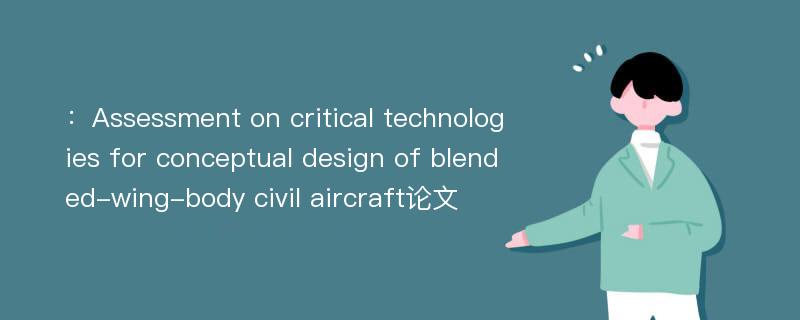
本文主要研究内容
作者(2019)在《Assessment on critical technologies for conceptual design of blended-wing-body civil aircraft》一文中研究指出:Civil aviation faces great challenges because of its robust projected future growth and potential adverse environmental effects. The classical Tube-And-Wing(TAW) configuration following the Cayley’s design principles has been optimized to the architecture’s limit, which can hardly satisfy the further requirements on green aviation. By past decades’ investigations the BlendedWing-Body(BWB) concept has emerged as a potential solution, which can simultaneously fulfill metrics of noise, emission and fuel burn. The purpose of the present work is to analyze the developments of critical technologies for BWB conceptual design from a historical perspective of technology progress. It was found that the high aerodynamic efficiency of BWB aircraft can be well scaled by the mean aerodynamic chord and wetted aspect ratio, and should be realized with the trade-offs among stability and control and low-speed performance. The structure concepts of non-cylinder pressurized cabin are of high risks on weight prediction and weight penalty. A static stability criterion is recommended and further clear and adequate criteria are required by the evaluations of flying and handling qualities. The difficulties of propulsion and airframe integration are analyzed. The energy to revenue work ratios of well-developed BWB configurations are compared,which are 31.5% and 40% better than that of TAW, using state-of-art engine technology and future engine technology, respectively. Finally, further study aspects are advocated.
Abstract
Civil aviation faces great challenges because of its robust projected future growth and potential adverse environmental effects. The classical Tube-And-Wing(TAW) configuration following the Cayley’s design principles has been optimized to the architecture’s limit, which can hardly satisfy the further requirements on green aviation. By past decades’ investigations the BlendedWing-Body(BWB) concept has emerged as a potential solution, which can simultaneously fulfill metrics of noise, emission and fuel burn. The purpose of the present work is to analyze the developments of critical technologies for BWB conceptual design from a historical perspective of technology progress. It was found that the high aerodynamic efficiency of BWB aircraft can be well scaled by the mean aerodynamic chord and wetted aspect ratio, and should be realized with the trade-offs among stability and control and low-speed performance. The structure concepts of non-cylinder pressurized cabin are of high risks on weight prediction and weight penalty. A static stability criterion is recommended and further clear and adequate criteria are required by the evaluations of flying and handling qualities. The difficulties of propulsion and airframe integration are analyzed. The energy to revenue work ratios of well-developed BWB configurations are compared,which are 31.5% and 40% better than that of TAW, using state-of-art engine technology and future engine technology, respectively. Finally, further study aspects are advocated.
论文参考文献
论文详细介绍
论文作者分别是来自Chinese Journal of Aeronautics的,发表于刊物Chinese Journal of Aeronautics2019年08期论文,是一篇关于,Chinese Journal of Aeronautics2019年08期论文的文章。本文可供学术参考使用,各位学者可以免费参考阅读下载,文章观点不代表本站观点,资料来自Chinese Journal of Aeronautics2019年08期论文网站,若本站收录的文献无意侵犯了您的著作版权,请联系我们删除。
